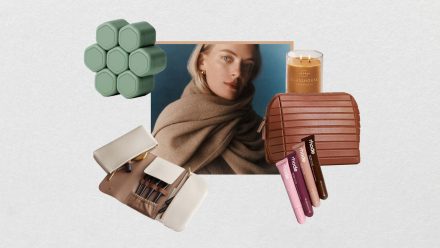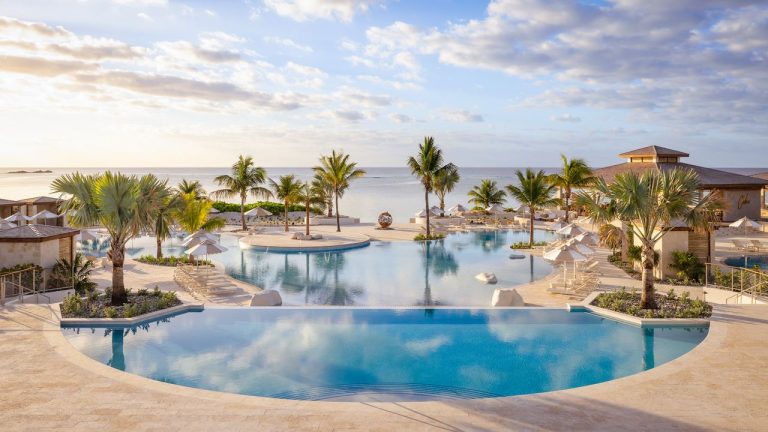All products and listings featured on Condé Nast Traveler are independently selected by our editors. However, we may receive compensation from retailers and/or from purchases of products through these links.
Generally speaking, my post-half-marathon recovery looks a little something like this: Go back to the hotel or Airbnb, stretch out on the floor for a few minutes, Hyperice the heck out of my legs, take a shower, and head back out to see more of whatever city I’m in. As my friends and I make our way through a goal of running this distance (13.1 miles) in every state, my recovery plan hasn’t evolved much beyond this routine. So when the opportunity presented itself to try the much more elevated suite of wellbeing services offered to amateur athletes like myself at Park Hyatt Chicago, I jumped on it.
Park Hyatt, located on the Magnificent Mile, sees an uptick in bookings leading up to the wildly popular fall Chicago Marathon. It also welcomes many local runners for both pre- and post-race meals. In response to a growing interest in mind-body health by travelers of all kinds, not just runners, the property has been expanding its wellness offerings. In addition to the services I was set to try, the hotel recently redesigned two of its suites, turning one into a Mindfulness suite and the other into a Wellbeing one, each kitted out with a Bryte Balance bed and an array of health-focused amenities.
I stayed in the Wellbeing Suite the night before and the night after I ran the Bank of America Chicago 13.1 race this June, a lovely course on a somewhat hotter day than expected. The space, an absolutely gorgeous suite, felt more like a (very upscale) apartment than a hotel room, with a large open living area looking out onto Lake Michigan; a Tonal machine in the corner; a minimalist, zen-like bedroom; and a massive bathroom with a walk-in rain shower and standalone tub. Upon arrival, juice shots, nuts, and fresh fruit were waiting for me (a major upgrade from the assortment of chips in the kitchen of the Airbnb I’d stayed in before my last half).
In addition to getting a great night’s sleep—the Bryte bed is designed to sense and relieve any pressure points—it was nice having a yoga mat (and bench) in my room for stretching purposes, rather than having to stop by the hotel gym or bring my own.
The morning after the race, I started my recovery day with a visit from Stephanie, a registered nurse who also works at a nearby hospital, and a DripIV. Stephanie got me set up with an IV treatment designed to help people “recover from workouts and illness quickly.” Vitamins B12 and C, Magnesium, Lipostat, and Glutathione go to work to “help boost immune function, reduce inflammation, and support faster muscle healing.”
Stephanie told me I’d be able to feel the benefits within a couple of hours, and that they’d last between 24 and 36 hours. While I’m not a fan of needles, it was quick and painless, and it was nice to have a reason to sit on the couch for an hour with nothing to do but chit-chat. Interestingly, you can feel a kind of cooling sensation as the vitamins enter your body, and taste the vitamins in your mouth from time to time. I started to notice the energy and recovery effects when I got up and started moving around. I was markedly less creaky than I usually am the day after a race. (Stephanie says the service is popular in Chicago with everyone from famous athletes to Joe Schmos; even businesses are getting in on it with office parties.)
Next, I headed to the hotel’s spa and indulged in an 80-minute Grounded massage, which incorporates the use of heated basalt stones. I found it to be a very balanced massage, and particularly enjoyed the heated table, head massage, and the focus on the areas of my body that were carrying a lot of tension—my neck and shoulders, lower back, and legs.
After the massage, the spa staff offered me juice and Prosecco and let me know that I could head back to my room, make use of the sauna, or relax by the pool. I went for the carrot juice and sipped it on a lounge chair by the indoor pool as I reveled in my loosened muscles and decreased hip tension.
I came back to an ice bath ready and waiting in my suite. If you haven’t done a cold plunge or ice bath before, know that it is going to be a quick experience, so the $100 price tag may be off-putting to some. I put my legs in for around 15 seconds; then got out and in again for 30 seconds, submerging my legs, torso, and chest this time. As with previous cold plunges, I felt instantly invigorated. It really wakes you up and gives you an adrenaline rush that a cold shower doesn’t quite match (you also don’t have to dunk your head or get your hair wet, helpful for anyone who’s about to go on with a regular day, like I was). This practice, increasingly popular with athletes, actors, and influencers, has been shown to reduce muscle soreness (more on that from our friends at Self).
The trio of services was an excellent combo. It’s difficult to parse which aided my recovery most, but what I am sure of is that I was walking around the rest of the day, and the following day, fairly normally. Usually, I’m hobbling around for at least a few days. Flying back home that night, my hips were annoying me a bit (it was hard to get comfortable—I should’ve packed my foot hammock!), but my back, shoulders, and legs were feeling surprisingly fine. The next day, I had no issue or pain going up stairs, a solid indicator for me of a faster recovery than usual.
Going forward, I plan on incorporating some kind of cold therapy as well as a massage when possible into my post-race recovery routine—especially on trips when I still have a few travel days after the half. To more advanced runners, 13 miles may be a casual weekend run, but for me, it’s an accomplishment every time, and one I ought to celebrate. And of course, my trusty massage gun and hydration essentials will still be in rotation.
These recovery services are available for any Park Hyatt guest to book, whether they’re staying in a suite or regular guest room (both types have tubs to accommodate the cold plunge). In a suite, though, you have ample space for all of the services to be done in-room should you prefer full privacy (or as little movement as possible). Or, you can head to the hotel’s NoMI Spa for your 80-minute massage ($275 at the spa, $315 in-room). DripIV options, which start at $249, will be available to book soon, and include drips designed to help with energy, dehydration, headache relief, and even hangovers.
More recovery experiences I’ve tried:
Since the Bank of America Chicago 13.1, I’ve run three more halfs (and my first full marathon!), and have tried out some more recovery methods. Here are a few I would recommend, and plan to go back to before and after future races.
Othership: I’m a big fan of Othership as a space to relax and recharge, especially before or after a race. The social wellness club is focused on hot/cold therapy, with a sauna and several cold plunge tubs to rotate through. There are two locations in New York and two in Toronto, and they are available to book directly or through Classpass. I’ve gone the day after a half a few times now and my legs always feel better for it.
Remedy Place: Another social wellness club option (this one with New York, LA, and Boston locations), Remedy Place is a real choose-your-own-adventure with pretty much every trendy wellness treatment you can think of: cryotherapy, IV drips, hyperbaric chambers, lymphatic compression beds, and on and on. I especially liked the Remedy Roller, which uses infrared lights to loosen muscles and move the lactic acid away from the body to speed up recovery. After a brief how-to, you’re in there by yourself, so you can really tailor the massage to the parts of your body that need it most.
Hyperice Normatecs: These are an investment, no doubt, but if you’re a lifelong runner, they really are worth it in my opinion. They’re too big to pack for destination races unless you want to check a bag, but if you’re driving to one, put them in the trunk—trust me, you’ll be happy to zip into them in your hotel room post-race. I use them after long training runs and for a few nights following a half, and they work wonders in terms of speeding up recovery.
Condé Nast Traveler does not provide medical advice, diagnosis, or treatment. Any information published on this website or by this brand is not intended as a substitute for medical advice, and you should not take any action before consulting with a healthcare professional. This article has been updated with new information since its original publish date.




